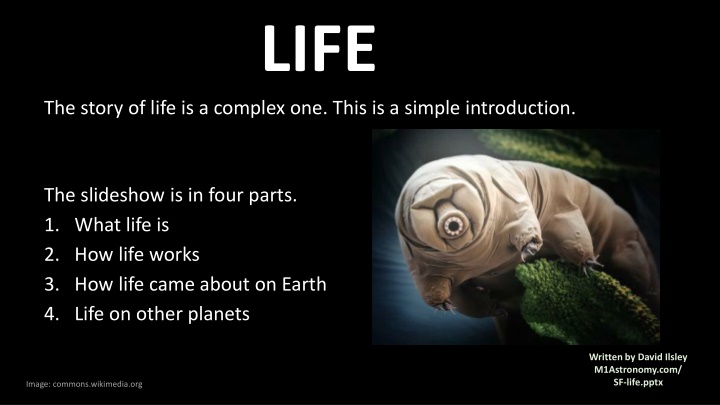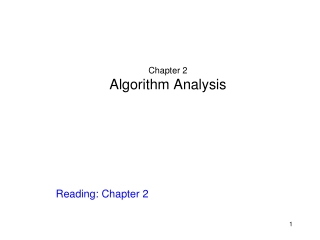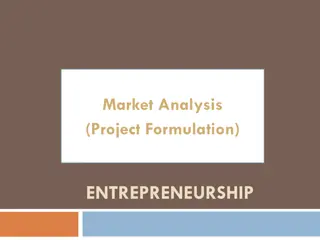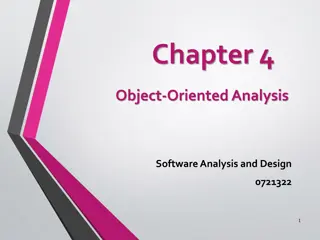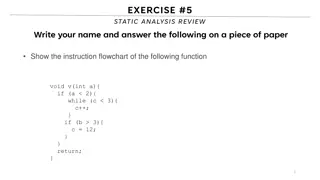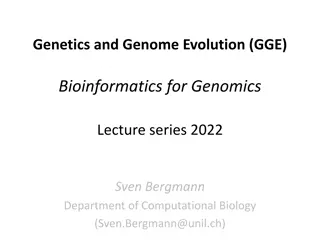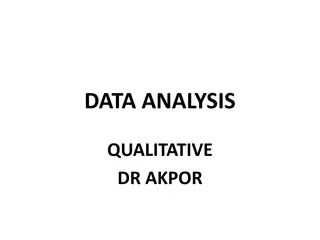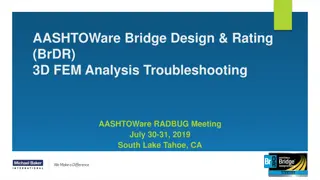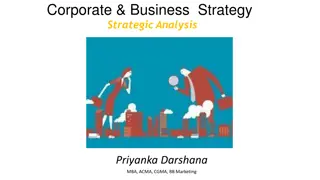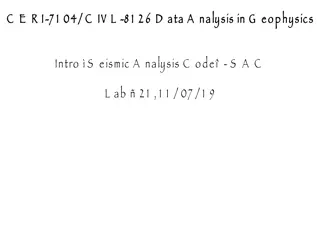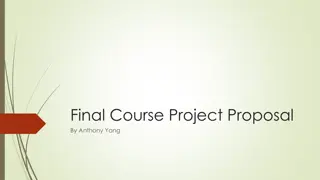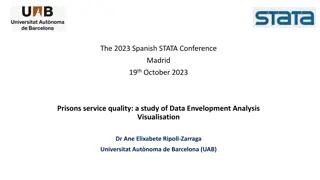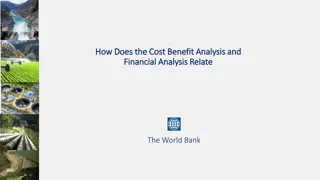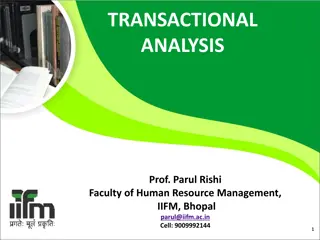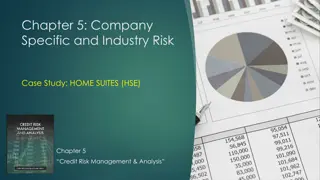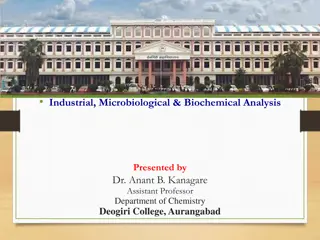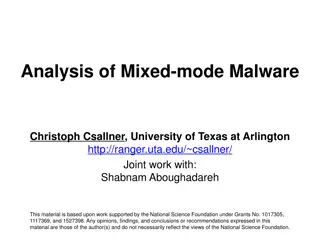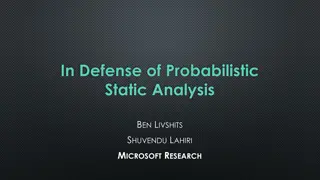Analysis on "Kambing Jantan" by Raditya Dika
The popular literature "Kambing Jantan" by Raditya Dika has garnered significant attention with its unique storytelling style and relatable characters. Through first-person narration, the plot unfolds in a humorous and engaging manner, captivating readers with its exploration of themes and settings. The book's success is evident in its multiple reprints and adaptation into other media forms.
Download Presentation

Please find below an Image/Link to download the presentation.
The content on the website is provided AS IS for your information and personal use only. It may not be sold, licensed, or shared on other websites without obtaining consent from the author.If you encounter any issues during the download, it is possible that the publisher has removed the file from their server.
You are allowed to download the files provided on this website for personal or commercial use, subject to the condition that they are used lawfully. All files are the property of their respective owners.
The content on the website is provided AS IS for your information and personal use only. It may not be sold, licensed, or shared on other websites without obtaining consent from the author.
E N D
Presentation Transcript
LIFE The story of life is a complex one. This is a simple introduction. The slideshow is in four parts. 1. What life is 2. How life works 3. How life came about on Earth 4. Life on other planets Written by David Ilsley M1Astronomy.com/ SF-life.pptx Image: commons.wikimedia.org
LIFE Image: WallpaperUse Part 1 What It Is
What is Life? A living thing is any collection of molecules which can produce a copy of itself. Life is the process by which living things maintain themselves and reproduce. Image: rawpixel.com
Reproduction can be either asexual or sexual. In asexual reproduction, a single organism produces a copy of itself. In sexual reproduction, two individuals of the same species, one male and one female, produce offspring with some characteristics of each. Image: flickr.com
If errors can occur in the reproductive process, then the offspring can be similar to their parent or to a combination of their parents, though with differences. This budgie is the result of a mutation which changed its feather colours from the usual green. Such errors are called mutations. All life on Earth is subject to mutations. Image: Wikipedia
In most cases, the mutations make the offspring unviable, and they just die. In other cases, the mutations won t kill the offspring, but will cause it to be deformed or less intelligent or in some other way disadvantage it relative to its peers. As such, it will be less likely to survive long-term and to reproduce. Image: picryl.com
In a very few cases, the mutations will produce offspring that have an advantage over others of their type, either in terms of their ability to survive or in terms of their attractiveness to a potential mate. They will then be more likely to reproduce and so the individuals with the new trait will become more common in the population. Over many generations they could possibly replace all those without the trait. Image: WallpaperUse
This is the process of evolution. Evolution allows species to change slowly over long periods of time. Image: commons.wikimedia.org The ability to evolve is sometimes built into the definition of life. But if we define life as a collection of molecules which can reproduce itself and accept that mutations occur during reproduction, then our definition covers evolution anyway.
Evolution works by natural selection: the individuals best adapted to their environment have the best chance of surviving and reproducing and so are naturally selected to produce later generations. If a species is well adapted to its environment, then any change will tend to be a disadvantage and the species will remain fairly much the same. However, if a species is not so well adapted, or if the environment changes, then some mutations may be advantageous, and the species will change to become better adapted. Image: commons.wikimedia.org
Sexual reproduction can increase the pace of evolution by combining the characteristics of two organisms, thus producing a larger variety of offspring types for natural selection to choose from. Image: flickr.com
And, as we have seen, it has the added evolutionary advantage in that it makes the better adapted individuals (which also tend to be the stronger and more attractive individuals) more likely to breed. Weak or defective individuals tend not to get a mate. This can be sad for the individuals, but good for the species. Image: flickr.com
Even with sexual reproduction, evolution is a process that, under natural conditions takes thousands to millions of years to make an appreciable difference to a species. However, deliberate selection can speed up the process. Over time, dog breeders have deliberately chosen dogs with certain characteristics to breed and so those characteristics have spread more rapidly than would occur naturally. Wild dogs a few thousand years ago have been bred into hundreds of very different breeds today. Image: rawpixel
How do we get a variety of different breeds from a single type of ancestor? By separating dogs which are a little different and letting them breed only with other dogs similar to themselves. This is the idea of a thoroughbred. The same thing happens in the natural world where a species spreads into areas with different environments, then adapts to those environments, those in different areas becoming different from one another. Eventually, they become so different that they will no longer breed with each other and we have two species instead of just one.
Life began on Earth somewhere around 4 billion years ago and there would have been many billions of generations since then. The incremental variations that occur from generation to generation have added up to cause primitive single-celled organisms like bacteria to evolve gradually into the millions of species we have today. Image: picryl.com
This diagram shows the basic types of organisms on Earth, and how they evolved from one another. The three domains are bacteria, archaea and eukaryotes. However, this doesn t include viruses, viroids or prions, which not everyone considers to be living. Image: commons.wikimedia.org
Bacteria and Archaea are all single- celled organisms around one thousandth of a millimetre in size. Though the two groups are distinguished by different chemistries, they have similar cell structure, something like the picture lower right. DNA floats around in the cytoplasm (purple tangle). This type of cell is called prokaryotic and bacteria and archaea are together called prokaryotes. Images: commons.wikimedia.org
The other organisms have eukaryotic cells and are called eukaryotes. Eukaryotes have larger more complex cells than prokaryotes as in the diagram below right. Their DNA is contained in a nucleus and they have various organelles including ribosomes which make proteins and mitochondria which generate energy by burning glucose. Many eukaryotes are single-celled like the prokaryotes. But three groups are multi-cellular: animals, plants and fungi. The diagram is a typical animal cell. Images: commons.wikimedia.org
This is a typical plant cell. Plant cells have chloroplasts containing the green chlorophyl, a cell wall outside the plasma membrane and a large vacuole to store sap. Image: commons.wikimedia.org
Although they are just one group in the previous diagram, animals do make up over half the species on Earth well over a million in total. This is the classification of animals. The top group, arthropods, includes insects, spiders, scorpions, centipedes, crabs, and prawns among many others. There are over a million species of insect, including 300 000 species of beetle. Image: commons.wikimedia.org
The group, chordata, includes vertebrates along with things like sea squirts, about 80 000 species in total. The vertebrates include fish, amphibians, reptiles, birds and mammals The mammals include mice, elephants, platypus, kangaroos, whales and primates. The primates include lemurs, tarsiers, tamarins, baboons, chimpanzees and humans. Image: commons.wikimedia.org
The diagram to the left shows stages in the development of life on Earth. Things like our present-day animals and plants all appeared since the Cambrian explosion, i.e. in the last 540 million years. Image: commons.wikimedia.org
All the above is about cellular life There are thought to be about 1031 viruses on Earth, more than there are cells in all the cellular organisms combined. Many people don t consider viruses to be alive because they can only reproduce by using the reproductive mechanisms of the cells they invade. But they are studied by biologists, rather than chemists and they can cause disease just bacteria can. Image: commons.wikimedia.org
Viruses consist of a bit or DNA or RNA in a protein case. They are much smaller than the smallest cells. They probably came into existence soon after cellular life, maybe from bits of stray RNA or DNA from damaged cells. Image: commons.wikimedia.org
Viroids are even simpler entities, just a circular string of RNA without even a protein coat. They can infect plants. A prion is just a protein molecule. But it can infect organisms and cause things like mad cow disease. Image: flickr.com Few people would call a prion a living thing. It seems there is no sharp divide between living and non-living things.
Of course, there is not universal agreement that this evolutionary model is the correct explanation for life on Earth. Close to half of the world s people who have an opinion on the matter consider sacred texts to be more reliable than observation and deduction and many believe that all the species were created in their present form by a supernatural being at some point in the more recent past. Image: flickr.com Interestingly, though, the pope is an evolutionist.
This slideshow presents the evolutionary model. For evolutionists, it should reinforce and elaborate upon their understanding. For creationists, it should broaden their understanding of the other side of the argument so that they can take a more informed stance against it. Image: flickr.com
LIFE Part 2 - How It Works Image: Negative Space
We have said that a living thing is any collection of molecules which can produce a copy of itself. All life on Earth uses pretty much the same way of producing those copies DNA. Image: rawpixel.com
DNA stands for deoxyribonucleic acid (not National Dyslexics' Association). A DNA molecule is a long thin strand in the shape of a spiral (a double helix) about a nanometre (one millionth of a millimetre) wide. It consists of C, H, O, N and P atoms (carbon, hydrogen, oxygen, nitrogen and phosphorus) (different colours in the picture). Image: rawpixel.com Image: flickr.com
This diagram shows how the atoms are arranged. The lines represent bonds between atoms. It is simplified by not showing the carbon atoms or all of the hydrogen atoms. Every unmarked corner or line end is a carbon atom; and if you count the lines coming out from that corner or end and subtract the number from 4, that gives the number of hydrogen atoms attached to that carbon atom. Image: commons.wikimedia.org
The left edge in the diagram is a phosphate-deoxyribose backbone consisting of alternating phosphate (PO4) units and deoxyribose units (the orange pentagons). Attached to each deoxyribose unit is a nucleobase. There are 4 different bases: adenine, thymine, guanine and cytosine. Image: commons.wikimedia.org
That makes up the left half of the strand. The right half is the same as the left half except that, where there is an adenine base on the left, there will be a thymine base on the right and vice versa, And where there is a guanine base on the left, there will be a cytosine base on the right and vice versa. The bases are connected by weak hydrogen bonds (dotted lines). Image: commons.wikimedia.org
The DNA strands are generally very long, consisting of millions of base pairs. In eukaryote cells, they roll up into compact shapes called chromosomes. Most chromosomes form an X- shape and they reside in the nucleus of each of our cells (except red blood cells). Image: commons.wikimedia.org
DNA makes copies of itself by splitting the strand down the middle. Each half strand then attracts molecules which bond with it to reconstruct the original strand. Image: commons.wikimedia.org
Strands of DNA floating in the sea, however, would soon be broken up. To survive, it needs to be contained in some sort of protective casing. This is where the primary function of DNA comes in. The sequence of bases in a DNA strand specifies a sequence of amino acids to produce a protein molecule. Each sequence of 3 bases specifies one of 20 amino acids. DNA in the nucleus splits and makes copies. The copies are made from RNA (ribonucleic acid), which is only very slightly different from DNA. The RNA strands, called messenger RNA, then leave the nucleus and join with the ribosomes in the cytoplasm to encode proteins. Image: rawpixel.com
Please excuse the Polish (or whatever it is). This is a ribosome. Messenger RNA (mRNA) feeds through it. Transfer RNA (tRNA) molecules, carrying amino acids, attach themselves temporarily to the mRNA and join their amino acid to the end of a growing protein chain. When the protein is complete it floats off through the cytoplasm to do its job. Image: Wikimedia Commons
Some of the protein molecules produce the protective casing in the form of a cell membrane. Images: commons.wikimedia.org Others act as enzymes which cause chemical reactions which produce fat and carbohydrate molecules and other cell constituents from simpler materials in the environment.
When DNA replicates (produces a replica of itself), the two copies move to opposite ends of the cell. The cell then divides, making two cells each with a copy of the DNA. Because the new cells have the same DNA, they produce the same proteins and therefore are basically the same as the parent cell. This is how single-celled organisms generally reproduce. Image: commons.wikimedia.org
Multi-cellular organisms grow new cells by the same process. They generally start life as single cell, which divides to 2, 4, 8 etc. Most multi-cellular organisms have differentiated cells, e.g. muscle cells, bone cells, nerve cells etc. Differentiated cells contain all the organism s DNA, though only some of it is activated to produce proteins. The mechanism for differentiation is not completely understood. Image: commons.wikimedia.org
Every one of the 30 trillion cells in an adult human body (except red blood cells) contains the full complement of the person s DNA with 6 billion base pairs making up 25 000 genes, each encoding one protein, on 46 chromosomes. Image: flickr.com
Sexual reproduction works a bit differently from normal cell division in that a cell divides to produce two gamete cells each with only half the parent s DNA. One gamete then combines with a gamete cell from the other partner to produce a fertilised cell with the full complement of DNA. This then divides and grows. Image: commons.wikimedia.org
LIFE Part 3 How It Came About Image: PickPik
It seems that the first cells came about on Earth around 4 billion years ago. How the first living things developed is still not completely understood. Many people assert that life cannot be made from non-living matter and that therefore it must have been created by supernatural intervention. Biologists mostly don t subscribe to this view. While we haven t worked out all the details, there seems to be no reason why the process couldn t have happened naturally. Image: commons.wikimedia.org
For a living cell to survive and reproduce, it needs three things: 1. A means of replication (this was probably RNA initially) 2. A container to protect the RNA and maintain the right chemical environment (a cell membrane) 3. A metabolism to provide the energy required to construct its parts and to maintain a life-style.
RNA The formation of RNA requires phosphate, ribose and four bases. All of these occur naturally on Earth and have even been found in meteorites, to it seem they occur throughout space. If present in sufficient concentrations, they can react to form RNA. Their concentration is naturally too low to allow this. But if a pool of water containing a low concentration of each is then mostly evaporated, a soup of sufficient concentration can be produced. Image: commons.wikimedia.org Some refer to this as the primordial soup.
Container Hydrocarbons in the soup will react to form lipids (also called fatty acids) hydrocarbon chains with a COOH group on one end. Image: commons.wikimedia.org
Lipids have a very convenient property: they naturally join together side to side to make a sheet. Image: flickr.com What s more, because the COOH end is bigger than the hydrocarbon end, the sheet tends to curve into a spherical vesicle. Image: Wikipedia
This vesicle will act as a primitive cell membrane isolating and protecting the soup inside which contains the ingredients necessary to form the RNA. Image: Wikipedia Another feature of such vesicles is that they can grow by the insertion of more lipid molecules. And, when they reach a certain size, they will naturally develop a bud and divide into two vesicles.
So, we have the means of producing a container which contains the ingredients for the production of RNA. Amino acids also occur naturally (and indeed in outer space). So, once we have the container with some RNA inside, we can start to produce proteins which can then lead to more complex cells. What we don t have yet is a source of energy a metabolism. Image: Wikimedia Commons
Metabolism The first cells couldn t get their energy as we do by eating other cells. There weren t any to eat. And as chlorophyl is complex and took a long time to develop, they couldn t get their energy from the sun as plants do. The most likely source of energy was the chemicals which come out of under- water volcanic hot springs. These emanations contain a lot of metal sulphides which will release energy when converted to sulphates. Image: PxHere
